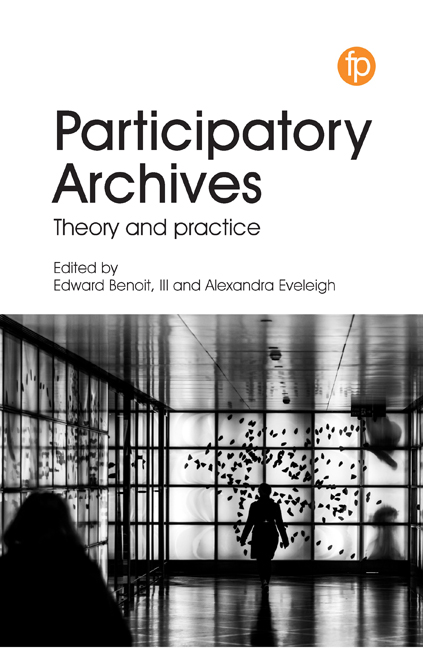Book contents
- Frontmatter
- Contents
- Figures and table
- Notes on contributors
- 1 Defining and framing participatory archives in archival science
- SECTION 1 SOCIAL TAGGING AND COMMENTING
- SECTION 2 TRANSCRIPTION
- 6 Engaging curation: a look at the literature on participatory archival transcription
- 7 Subtle transformations: increasing participation and access through transcription
- 8 Crowdsourcing metadata for time-based media in the American Archive of Public Broadcasting
- 9 Participatory transcription in Amsterdam and Copenhagen
- SECTION 3 CROWDFUNDING AND OUTREACH
- SECTION 4 ALTERNATIVE AND ACTIVIST COMMUNITIES
- Notes
- Index
7 - Subtle transformations: increasing participation and access through transcription
from SECTION 2 - TRANSCRIPTION
Published online by Cambridge University Press: 25 October 2019
- Frontmatter
- Contents
- Figures and table
- Notes on contributors
- 1 Defining and framing participatory archives in archival science
- SECTION 1 SOCIAL TAGGING AND COMMENTING
- SECTION 2 TRANSCRIPTION
- 6 Engaging curation: a look at the literature on participatory archival transcription
- 7 Subtle transformations: increasing participation and access through transcription
- 8 Crowdsourcing metadata for time-based media in the American Archive of Public Broadcasting
- 9 Participatory transcription in Amsterdam and Copenhagen
- SECTION 3 CROWDFUNDING AND OUTREACH
- SECTION 4 ALTERNATIVE AND ACTIVIST COMMUNITIES
- Notes
- Index
Summary
While the notion of public participation in cultural institutions has been around since the 19th century, it was the advent and growth of Web 2.0 tech - nologies since the 1990s that facilitated crowdsourcing activities. In turn, these partici patory projects have transformed the relationship between the galleries, libraries, archives and museums (GLAM) cultural heritage sector and the public.1 GLAM patrons have been able to generate their own web content, engage in social networking sites, and interact virtually and collaborate with one another on crowdsourcing activities such as transcriptions. Of particular note is the growing corpus of participatory transcription projects that have emerged since the early 2010s, which has demonstrated how crowdsourcing can be integrated into existing archival access and description practices. As archives are increasingly experimenting with and incorporating crowdsourcing at their institutions as a means to transcribe their holdings, it is important to examine the implications of this activity beyond the project or organisational level.
While transcription is considered to be one of the more conservative and mechanical participatory activities within the Web 2.0 crowdsourcing canon, the growing adoption of transcription projects by archives is indicative of broader shifts in what we conceive of as archival description and access and how we achieve it. This chapter explores the ongoing relationship between participatory transcription and archives, especially how the former, as both an act and a product, is impacting archival thought and the roles and relationships of archival communities. First, we begin by considering how crowdsourced transcription allows for multi-relational modes of description and access that challenge traditional conceptions of provenance and original order. The development of moderation protocols for crowdsourced transcription projects have helped archives negotiate the use of transcription in digital environ - ments.
Next, we look at how participatory transcription work enables members of the public to engage actively with collections, cultural institutions and one another. In the past, they typically were passive participants within cultural heritage institutions who could only view collection materials and the end products of institutional work, such as finding aids and metadata. While some users may then go on to use that information to create their own works, they did not produce content for the cultural institutions or collaborate with heritage professionals.
- Type
- Chapter
- Information
- Participatory Archives , pp. 85 - 94Publisher: FacetPrint publication year: 2019



